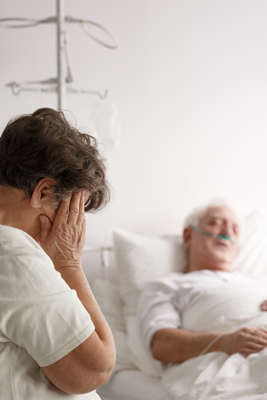Free Case Evaluation
You will never be charged a fee unless a recovery is made for you.
Bedsores—also known as pressure ulcers, decubitus ulcers, and pressure sores—are all-too common among residents of nursing homes and assisted living facilities. Common, and also potentially dangerous. Those bedsores might also be signs of neglect.
If you know or suspect that your loved one has developed bedsores or been abused while in a nursing home, call us at 800-796-1636 or submit your case details online and someone will contact you shortly. You pay nothing unless your lawsuit is successful and you receive compensation.
At Trustwell Law, our experienced attorneys take a personalized, compassionate approach. We cut through the legalese and partner with our clients. We have access to the expertise, resources, and manpower to fully investigate each case and fight for and with our clients to get the justice they deserve.

Bedsores are injuries to the skin and underlying tissue caused by prolonged pressure or friction on a particular part of the body. Elderly people with mobility issues are at increased risk for developing bedsores due to their age, thinner skin, and lack of mobility. Individuals confined to a wheelchair are also at increased risk of developing bedsores. Dehydration and malnutrition, as well as extended exposure to moisture, such as urine or feces, also increase the likelihood of developing bedsores.
People at increased risk of developing bedsores include:
Bedsores typically form on bony or protruding areas of the body with less tissue to act as padding under the skin. For people confined to their bed, bedsores most often develop on:
In people who use wheelchairs, pressure sores often form on:
The warning signs and symptoms of bedsores are:
Bedsores can develop over hours or days. They are categorized and described based on their depth and severity, among other characteristics. The degree of damage to the skin and tissue ranges from changes in skin color to severe injuries involving the skin, underlying tissue, and bone.
Bedsores are categorized in four stages of development.
Stage 1: Stage 1 is the mildest. Bedsores in stage 1 only affect the upper layer of skin. Symptoms of a stage 1 bedsore may include burning, pain, or itching. The area may also feel different than the surrounding skin—it may be firmer or softer, warmer or cooler.
Stage 2: When the sore digs deeper into the skin, it becomes a Stage 2 bedsore. At Stage 2, the skin is broken; it is an open wound and may look like a pus-filled blister. The area is swollen, red, and warm. Stage 2 bedsores are painful.
Stage 3: Stage 3 bedsores occur when the sore has gone through a second layer of skin into the fatty tissue. A Stage 3 bedsore looks like a crater and may have an unpleasant smell. The tissue around the sore will be black if that tissue has died.
Stage 4: Stage 4 bedsores are the most serious. They are big and deep and may affect muscles and ligaments. The skin has turned black and shows obvious signs of infection, including reddened edges, pus draining, a foul smell, and heat. Tendons, muscles, and bone may be visible in the wound.
Medical personnel may categorize even more severe bedsores using two other terms—unstageable bedsores and bedsores with suspected deep tissue injury.
Unstageable: An unstageable bedsore is one where the bottom of the sore can’t be seen, so it’s not possible to tell how deep it is until a doctor cleans it out.
Suspected Deep Tissue Injury (SDTI): Doctors refer to a bedsore as SDTI when the surface of the skin makes it appear as a stage 1 or 2 bedsore, but under the surface the bedsore is, in fact, a Stage 3 or 4 bedsore.
Bedsores occur when a person spends too much time in one position. They are avoidable if caregivers frequently reposition people with limited mobility. And if a bedsore is found early, it can be treated and will heal fairly quickly.
When a person living in a nursing home or assisted-care facility develops bedsores, it may very well be a sign of neglect. Caregivers should be expected to reposition their patients frequently to prevent bedsores. Caregivers also should be trained to examine their charges for signs of bedsores, so that if a bedsore starts to develop, it can be treated immediately and does not become a serious or dangerous wound. And, of course, staffing in the nursing home or assisted-living facility should be sufficient to adequately care for the residents, including keeping them clean and monitoring their eating to ensure they are adequately nourished.
If you have a family member or loved one living in a nursing home or assisted-living facility who has developed bedsores and want to consult a nursing home abuse lawyer to discuss their situation, contact us for a free consultation.
Sources
Agency for Healthcare Research and Quality. (2012, September). Preventing Pressure Ulcers in Hospitals. Retrieved from https://www.ahrq.gov/patient-safety/settings/hospital/resource/pressureulcer/tool/index.html
Grada, A., and T. Phillips. (2021, September). Pressure Injuries. Retrieved from https://www.merckmanuals.com/professional/dermatologic-disorders/pressure-injury/pressure-injuries?autoredirectid=13191
Mayo Clinic. (2022, April 19). Bedsores (pressure ulcers). Retrieved from https://www.mayoclinic.org/diseases-conditions/bed-sores/symptoms-causes/syc-20355893
MedlinePlus. (2022, April 17). How to care for pressure sores. Retrieved from https://medlineplus.gov/ency/patientinstructions/000740.htm
Park-Lee, E. (2009, February). Pressure Ulcers Among Nursing Home Residents: United States, 2004. Retrieved from https://www.cdc.gov/nchs/products/databriefs/db14.htm
Samuels, C. (2020, August 20). Elderly Bedsore Treatment, Stages, and Prevention. Retrieved from https://www.aplaceformom.com/caregiver-resources/articles/elderly-bedsores
SCI Model Systems. (n.d.). Recognizing and Treating Pressure Sores. Retrieved from https://msktc.org/sci/factsheets/recognizing-and-treating-pressure-sores
Smith, D. (1995, September 15). Pressure ulcers in the nursing home. Retrieved from https://pubmed.ncbi.nlm.nih.gov/7639444/
WebMD. (2020, November 11). What Are the Stages of Pressure Sores. Retrieved from https://www.webmd.com/skin-problems-and-treatments/pressure-sores-4-stages
You will never be charged a fee unless a recovery is made for you.